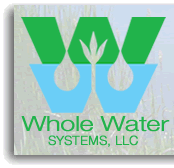The LEED rating system by USGBC
    
The United States Green Building Council (USGBC) created LEED (Leadership in Energy and Environmental Design) as a rating system for green building. Green building refers to the design, construction, and operation of buildings in an environmentally friendly way. LEED promotes a whole-building approach to sustainability by addressing performance in five key areas of human and environmental health: sustainable site development, water savings, energy efficiency, materials selection, and indoor environmental quality. There are currently nine different branches of LEED, each applying to a different aspect of green building: New Construction, Core and Shell, Schools, Healthcare, Retail, Commercial Interiors, Retail Interiors, Existing Buildings, and Existing Schools. LEED certification is broken into different levels and eligibility is based on a point system of which each rating system has it's own.
Whole Water Systems can help your project earn up to 12 LEED points for your certification.
SS Credit 6.1 – Stormwater Design - Quantity Control – 1 pt
As part of our comprehensive water management (catchment, treatment, use, reuse), we mitigate the development impact of stormwater runoff on surrounding hydrology. Rainwater catchment, catchment basins, and green surfaces all prevent post-development discharge rates from exceeding pre-development stormwater discharge rates.
SS Credit 6.2 – Stormwater Design - Quality Control – 1 pt
To limit the pollution of stormwater runoff, Whole Water Systems offers a range of systems that pretreat stormwater before it is either reused as non-potable or discharged. Our CWB (constructed wetland bioreactor) provides tertiary-level treatment for stormwater and is accepted as a BMP for stormwater design.
WE Credit 1 - Water Efficient Landscaping, - 2-4 pts
50% reduction = 2 pts | 100% (no potable water used) = 4 pts
Depending on the location (urban or suburban) and climate of a building, landscape irrigation can consume a large percentage of a potable water budget. To reduce this volume, we design and construct integrated catchment (rainwater cisterns / catchment basins) systems to supplant potable water with rainwater. We also design systems (CWB/RFB/VBR) which treat greywater and wastewater effluent to tertiary standards so that the purified water can be then used for drip-irrigated landscaping.
WE Credit 2 – Innovative Wastewater Technology – 2 pts
The intent of this credit is to “reduce wastewater generation and potable water demand while increasing the local aquifer recharge”. Using rainwater catchment systems, we will offset the amount of potable water used for waste conveyance. Our constructed wetland bioreactors treat 100% (only 50% is required) of the waste stream to tertiary standards wherein the purified water can be either reused for irrigation or as aquifer recharge.
WE Credit 3 – Water Use Reduction – 2-4 pts
30% reduction = 2pts | 35% reduction = 3pts | 40% reduction = 4pts
The intent of this credit is to reduce the burden on municipal water supply and increase efficiency of water used within the building (not including irrigation) Among the Whole Water Systems’ means for assisting this credit are treatment and use of captured rainwater or use of recycled water in toilets and urinals for transferring waste. This credit calls on implementation of high-efficiency fixtures such as water closets, urinals, lavatory faucets, showers, kitchen sink faucets and pre-rinse spray valves, Whole Water Systems assists in the intent of the credit by lowering water use below the water use baseline.
|


